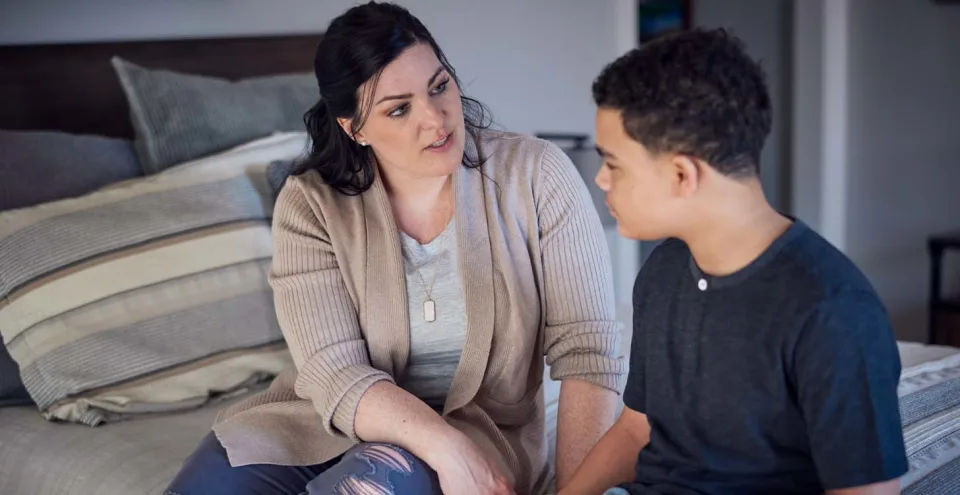How parents can help kids handle scary news, experts say

Whether it’s the latest school shooting, pandemic, natural disaster, ongoing war or climate change, the daily barrage of heavy news on TV and social media can be scary and overwhelming for children and teens.
But experts say parents can take steps to help their children process and discuss sensitive news topics in an age-appropriate way that doesn’t cause anxiety or affect their sense of security. That’s it.
Start from a calm place
“First, make sure you’re in an emotionally sound place,” Jessica Yellin, former chief White House correspondent for CNN and founder of News Not Noise, told Yahoo Life. “If you’re panicking or overly anxious, your child will realize it, but it won’t be productive. It’s OK to be emotional – let them know you’re sad, but they’re safe, and remind them of what you all did to make sure your child is safe.”
Jacqueline Toner, a psychologist and author of the book “What to Do When the News Scares You,” agrees, noting that there is an important difference between parents sharing that they are feeling sad and scared. “If your child is older, you can share your concerns, too, but be sure to discuss things that alleviate those concerns,” Toner said. “However, for younger children, it can be scary to hear that mom or dad is scared.”
Find out what kids already know
First rule of thumb: “Before you start explaining or expressing comfort,” assess what your child has heard or seen, Toner advises. “You may find that your child’s concerns are different from what you expected. Are they worried about their own safety? The safety of a loved one? Pets? Understanding what the news story means to your child is important to address their concerns.”
Yellin agrees, and says there are two benefits to finding out what kids already know first: “You don’t over-share traumatic information they may not have been exposed to yet, and you can focus the conversation on addressing their fears and concerns.”
You also don’t need to pretend to have simple answers to burdensome, complex topics. “Kids can find dishonesty, and it makes them more scared,” Yellin says. “But be honest and explain what the challenge is, why it’s a problem, and what people are doing to try to fix it.”
Remember, some kids may “misunderstand” news events
Toner explained that children are “more likely” to misunderstand the details of news events than adults, and may need some background information from their parents. “This can lead to specific fears or a general sense of anxiety,” Toner said. “Even if that’s not the case, children may see the news event as a direct threat to them. They may misunderstand how close the event is to where they live or how unlikely they are to have had a similar experience.”
Current events portrayed on television or the Internet often “show the same scenes over and over again, sometimes from different perspectives,” which can give the impression that “past events are still happening,” Toner said. When a scene fills an entire screen, she said, “it can seem broader than it actually is.”
Limiting exposure to horror news
This applies to both children and adults, Yellin notes. “Exposure to too much traumatic material can immobilize you,” she says. Instead, focus on the basics rather than getting bogged down. “To make sure you feel engaged and present, learn enough about the tragedy to understand the situation, then move on to material about solutions, actions and people who make a difference,” Yellin says. “In other words, you don’t need to know every step of the shooter’s, vivid story of the attack.”
That’s what Yellin himself does when journalism is not a noise letter, providing only “the most basic information about what’s going on” and focusing on “useful facts and people who are pursuing policy solutions – because that’s where you can more effectively channel your energy. Yellin recommends that parents find the same resources – common sense media, for example, has a list of kid-friendly news sources – and “Stop reading or watching when you feel overwhelmed.”
Reassuring children to help reduce anxiety
Of course, it’s impossible to completely protect children from hearing news that the entire country or world is watching, Toner says. To help create a sense of normalcy and safety, she suggests sticking to your usual family routine – it’s comfortable for children to be predictable – and giving them more hugs and attention if they need it.
It also helps to remind them of “all the people who will keep them safe,” Toner says. “But don’t mention any behavior that might increase the perception of danger. In other words, it’s fine to say the police are helpers, but don’t talk about their guns, shootings or bad actors,” for example.
Yellin added that parents should remind their children that “this event is the news. Their lives are what’s happening in this space right now, and it’s safe for them to have that conversation.”
While reassuring your child, you can also take the opportunity to turn any grief or concern into action. “Helping them think about how they can express their concern for the injured person – through letters, help getting dressed, etc. – can even serve as a lesson in compassion,” Toner says.
